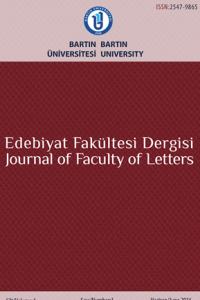ÇİVİ YAZILI BELGELER VE ANTİK KAYNAKLAR IŞIĞINDA PERS İMPARATORLUĞU’NUN KURULUŞU
Pers İmparatorluğu’nun kurulması Eskiçağ tarihinde önemli bir yere sahiptir.Pers İmparatorluğu’nun kurulmasıyla birlikte özellikle Yakındoğu’nun siyasi yapısındaköklü değişiklikler yaşanmıştır. Bu güçlü İmparatorluğun ortaya çıkışıyla ilgili bilgiler,çivi yazılı belgeler ve Antikçağ yazarlarının eserleri vasıtasıyla günümüze ulaşmıştır.Çivi yazılı belgelere göre Pers soyundan gelen Büyük Kyros (M.Ö. 559‐530) ile MediaKralı Astyages (M.Ö. 585‐550) arasında gerçekleşen savaşı Büyük Kyros kazanmış veM.Ö. 550’de Pers İmparatorluğu’nun temellerini atmıştır. Antikçağ yazarlarınıneserlerindeki bilgiler ayrıntıya girildikçe farklılaşsa da temel bakımdan benzerdirler.Bu eserlerin hemfikir olduğu en önemli nokta Büyük Kyros’un Astyages’le yaptığısavaşı kazanarak Pers İmparatorluğu’nu kurmasıdır. Büyük Kyros, Media Krallığı’nınbaşkenti Ekbatana’yı ele geçirmesinin ardından, daha önce Elam Krallığı’na başkentlikyapmış olan ve sonrasında ise Media Krallığı’nın en önemli şehirlerinden birisidurumuna gelen Susa’yı ele geçirmiştir.
Anahtar Kelimeler:
Büyük Kyros, Pers İmparatorluğu, Media Krallığı, Akamenidler, Medler
FOUNDATION OF THE PERSIAN EMPIRE IN THE LIGHT OF CUNEIFORM DOCUMENTS AND ANCIENT SOURCES
The foundation of the Persian Empire, has an important place in ancient history.With the foundation of the Persian Empire, in particular The Near East’s politicalstructure has been fundamentally changed. Informations about the emergence of thispowerful empire has survived through the cuneiform documents and works ofantiquity authors. According to cuneiform documents, Cyrus the Great, a descendantof Persia (559‐530 B.C.) won the war against Astyages (585‐550 B.C.) King of Mediaand it has laid the foundations of the Persian Empire in B.C. 550. Although thedifferentiation of the information from the works of ancient authors by detailedexamination, they are similar in primary care. All these documents agreed that the most important point, Cyrus the Great’s is establishing the Persian Empire by winningthe war against Astyages King of Media. After conquering Ecbatana the capital ofKingdom of Media, Cyrus the Great conquered Susa which had previously been thecapital of the Kingdom of Elam and afterward, had became one of the most importantcity of Kingdom of Media.
Keywords:
Cyrus the Great, The Persian Empire, The Median Kingdom, The Achaemenids, The Medes,
___
- KAYNAKÇA
- Briant, Pierre, From Cyrus to Alexander A History of the Persian Empire, (Translated by Peter T. Daniels), Winona Lake, Indiana: Eisenbrauns, 2002. Dandamayev, M. A. “Media and Achaemenid Iran”, History of Civilizations of Central Asia: The Development of Sedentary and Nomadic Civilizations: 700 B.C. to A.D. 250, (Editor: János Harmatta), Volume 2, Paris: UNESCO Publishing, 1996, s. 35‐64. _______, “Babylonia in the Persian Age”, The Cambridge History of Judaism, Volume 1, New York, 1984, s. 326‐342. Diakonoff, I. M., “Media”, The Cambridge History of Iran, Volume 2, Cambridge, 1985, s. 36‐148. Diodorus Siculus, Diodorus of Sicily, (English Translation by: C. H. Oldfather), Cambridge, Massachusetts: Harvard University Press, 1935‐ 1946. Əliev, İqrar, “Azərbaycan Torpaqları Fars Əhəmənilər (Haxamanişilər) Dövlətinin Tərkibində”, Azərbaycan Tarixi Ən Qədimdən Bizim Eranın III Əsri, (Redaktor: İqrar Əliev), Bakı: Azərbaycan Milli Elmlər Akademiyası A. Bakıxanov Adına Tarix İnstitutu, 2007, s. 202‐212. FGrHist=Die Fragmente der griechischen Historiker. Jacoby, F. (1923‐ 1958). Berlin and Leiden: E. J. Brill. Finkel, Irving, “Translation of the Cyrus Cylinder”, Cyrus the Great An Ancient Iranian King, (Edited by: Touraj Daryaee), Santa Monica: Afshar Publishing, 2013, s. 78‐84. Gray, G. Buchanan, “The Foundation and Extension of the Persian Empire”, The Cambridge Ancient History, Volume 4, London, 1926, s. 1‐25. Herodotos, Herodot Tarihi, (Çeviren: Müntekim Ökmen), İstanbul: Remzi Kitabevi, 1983. Ksenophon, Kyros’un Eğitimi (Kyrou Paideia), (Çeviren: Furkan Akderin), 1. Baskı, İstanbul: Alfa Yayınları, 2007. Kuhrt, Amelie, Eskiçağ’da Yakındoğu Yaklaşık M.Ö. 3000‐330, (Çeviren: Dilek Şendil), 1. Baskı, Cilt 2, İstanbul: Türkiye İş Bankası Kültür Yayınları, 2009. _______, The Persian Empire: A Corpus of Sources from the Achaemenid Period, Volume 1, New York: Routledge, 2008. Marcus Junianus Justinus, Epitome of the Philippic History of Pompeius Trogus, (Translated with notes by the Rev. John Selby Watson, Henry G. Bohn), London: Covent Garden, 1853. Oates, Joan, Babil, (Çeviren: Fatma Çizmeli), Ankara: Arkadaş Yayınevi, 2004. Petit, Thierry, Satrapes et Satrapies dans l'empire achéménide de Cyrus le Grand à Xerxès Ier, Paris: Les Belles Lettres, 1990. Polyainos, Strategemata, (Edited by: E. Woelfflin and J. Melber), Leipzig: Teubner, 1887. Polybius, The Histories, (Translation by William Roger Paton), Volume 6, Cambridge, Massachusetts: Harvard University Press, 1922‐1927. Rawlinson, George, Eski Doğu’nun Büyük Krallıklarından Medya Krallığı, (Çeviren: Nadire Işık), 1. Baskı, İstanbul: Doz Yayıncılık, 2006. Rollinger, Robert, “Med Krallığı”, Arkeoatlas, Sayı 6, 2007, s. 8‐18. Sarıkaya, Sevgi, “Babil Kuneiform Tabletleri ile Antik Kaynaklar Işığında Media, Lydia ve Küçük Asya Fatihi Büyük Kyros”, Mediterranean Journal of Humanities, Cilt 1, Sayı 2, 2011, s. 195‐211. Strabo, Geography, (with an English translation by Horace Leonard Jones), Volume 7, Cambridge, Massachusetts: Harvard University Press, 1930. van de Mieroop, Marc, Antik Yakındoğu’nun Tarihi, (Çeviren: Sinem Gül), 1. Baskı, Ankara: Dost Kitabevi, 2006. van der Spek, R. J., “Cyrus the Great, Exiles and Foreign Gods: A Comparison of Assyrian and Persian Policies on Subject Nations”, Extraction and Control: Studies in Honor of Matthew W. Stolper, (Edited by: Michael Kozuh, Wouter F. M. Henkelman, Charles E. Jones and Christopher Woods), Chicago: Oriental Institute of the University of Chicago, 2014, s. 233‐264. Waters, Matt, “Cyrus and Susa”, Revue d'assyriologie et d'archéologie orientale, Volume 102, 2008, s. 115‐118.
- ISSN: 2602-3520
- Yayın Aralığı: Yılda 2 Sayı
- Başlangıç: 2016
- Yayıncı: Bartın Üniversitesi
Sayıdaki Diğer Makaleler
OSMAN HAKAN A.’NIN SARI EKİN ADLI KİTABINDA GELENEK ETKİSİ
OSMANLI KADINLARI ARASINDA MODANIN YAYGINLAŞMASINDA BİR ARAÇ OLARAK BİÇKİ‐DİKİŞ
KEMAL TAHİR DÜŞÜNCESİNDE GERÇEĞİN DEĞİŞKENLİĞİ BAĞLAMINDA OSMANLILIK OKUMALARI
PEYAMİ SAFA’NIN BİR TEREDDÜDÜN ROMANI ADLI ESERİNDE LUİGİ PİRANDELLO TESİRİ
PAPHLAGONİA’DA BİR PERS PRENSESİ VE ONUN KENTİ: AMASTRİS
KLÂSİK TÜRK ŞİİRİNDE ANNE İMAJININ ELE ALINIŞ ŞEKİLLERİ
ÇİVİ YAZILI BELGELER VE ANTİK KAYNAKLAR IŞIĞINDA PERS İMPARATORLUĞU’NUN KURULUŞU
